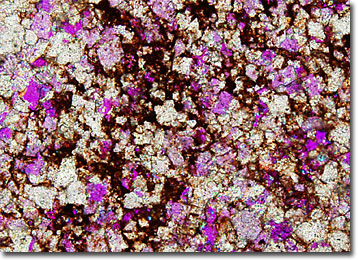Polarized Light Microscopy Digital Image Gallery
Diffusion Dolomite
Rocks traditionally referred to as dolomites are becoming increasingly known as dolostones in order to avoid their confusion with the calcium magnesium carbonate mineral they characteristically contain, which is also called dolomite. Relatively common and widespread, these rocks comprise as much as two percent of the Earth’s crust.

Dolomite is a kind of carbonate rock that is similar to limestone, but is generally heavier and harder than that type of sedimentary rock. Due to their analogous nature, dolomite is often utilized in place of limestone in a variety of applications, especially as an aggregate in cement mixes. The rock also gains frequent use as a building stone, and when it undergoes metamorphism it becomes dolomitic marble, which is popularly utilized for ornamental purposes. However, due to the beautiful colors and variegated forms it exhibits and the good polish it may take even in its unchanged form, dolomite that has not metamorphosed is also frequently sold as marble.
Quite various, dolomites are often named according to a variety of classification systems, such as those based upon parent material, type locality, mineralogical composition, or formation method, in order that the rocks may be more distinctively identified. Diffusion dolomite, for instance, is a type of the rock that has been appreciably affected by the migration of chemical elements through magma in response to gradients in temperature, pressure or chemical state. Oranogenic dolomite, on the other hand, is typically a cement that contains relatively minor amounts of strontium and manganese. Some of the other many varieties of the rock include methanogenetic dolomite, variegated dolomite, and the Potosi Dolomite.
